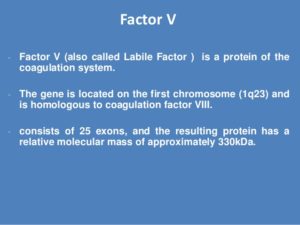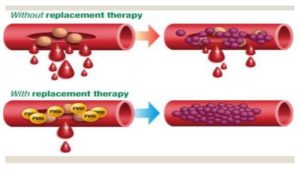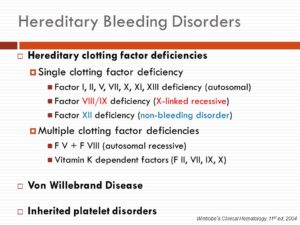Factor V (FV) deficiency was first described in a Norwegian patient in 1943 and reported by Dr. Paul Owren in 1947. Its incidence is about 1 in 1 million; fewer than 200 cases have been documented worldwide. It should not be confused with factor V Leiden, a clotting disorder.
The FV protein is a catalyst, accelerating the process by which prothrombin is converted to thrombin, the initial step in clot formation. FV deficiency is usually inherited in an autosomal recessive fashion, meaning both parents must carry the gene to pass it on to their children; it affects men and women equally.
Symptoms
Common characteristics of FV deficiency are bruising, bleeding under the skin, and nose, gum and mouth bleeds. Babies with severe FV deficiency are at increased risk of intracranial hemorrhage, or bleeding in the brain. People with severe FV deficiency can also experience bleeding in the lungs and gastrointestinal tract, which can be life threatening. Women frequently have menorrhagia, long, heavy periods.
Testing
Diagnosis is made through activated partial thromboplastin time (aPTT) test, prothrombin time (PT) test and thrombin clotting time (TCT) test. Diagnosis can be confirmed with a factor V assay. Factor V is found in both plasma and platelets, so platelet function may be affected.
Treatment
Fresh frozen plasma (FFP) is the only treatment available, as no commercially available factor V concentrate exists. In acute cases of severe bleeding, the addition of platelet concentrates may be needed. Solvent-detergent FFP may contain a more reliable level of FV than standard FFP.
Combined FV/FVIII Deficiency
Combined factor VIII (FVIII) and factor V deficiency is a very rare disorder, found in fewer than 100 patients from 60 families worldwide, mostly in Iran, Israel and Italy. Most cases are mild to moderate. Symptoms can include frequent nosebleeds, easy bruising, and excessive bleeding after injury or surgery. Women can experience menorrhagia and postpartum hemorrhage. Treatment includes fresh frozen plasma. In some cases, bleeds may be treated with FVIII concentrates and desmopressin acetate, the synthetic version of the hormone vasopressin.


